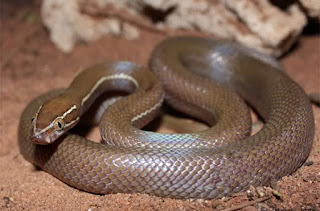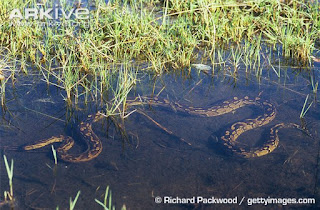 |
| Adult brown house snake. |
Brown house snakes are one of many species of African
house snakes found across sub-Saharan Africa. They are medium in size and non-venomous
with a variety of patterns and may be striped, spotted or even solid in colour.
African house snakes are sexually dimorphic, meaning that females grow to be
larger than their male counterparts, with females reaching up to 783 mm and males up to
656 mm in length.
Brown house snakes are light brown to reddish brown in
colour and darken with age on top while their underparts are an off white
colour. There are two distinctive pale yellow streaks running across each side
of the head from the tip of the snout through the eye but do not run down more than a third of their body length.
Habitat
African house snakes, as mentioned are found throughout
sub-Saharan African, are able to adapt and live in a variety of habitats. They
are referred to as ‘house’ snakes due to often being found settled under stones
or in rocky areas of gardens and in the homes of people. These snakes live in
underground borrows, scrublands, woodlands, savannah and mountainous areas.
Behaviour
African house snakes that have ventured from the wild
are often very nervous if approached by humans and will try to slither away in
response. Brown house snakes and their relatives are said to make good pets and
make for the perfect first choice of snake for a beginner.
Some may become aggressive during feeding, eating all
the food for themselves and preventing others from feeding. In some cases, ravenous
hatchlings will eat their smaller brothers and sisters, so it is suggested that
all hatchings are best kept apart.
 |
| Juvenile brown house snake. |
Diet
Adult brown house snakes eat mostly rodents but will
also feed on frogs, lizards and birds while juvenile snakes eat lizards and geckos.
These snakes are powerful constrictors; able to snatch
rodents in their jaws before unleashing a strong and deadly grip around the
prey. Once the rodent is no longer alive, the grip is released and the
unfortunate victim is eaten head first.
Reproduction
House snakes lay up to 16 eggs in the summer month among
vegetable debris or compost, on average 2 months after mating. Females usually
stop eating after the first month of gestation and begin a shed cycle before
laying her eggs 5 to 10 days later. Hatchlings take between 60 and 75 days to
develop within the egg before hatching. When born, hatchings are around 20 cm
in length and begin to shed within a week of leaving their eggs.
Did you know?
Those that prey on brown house snakes are larger snakes
and birds of prey.









